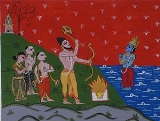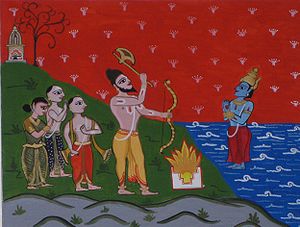
Hinduism in Goa
Encyclopedia

Konkan
The Konkan also called the Konkan Coast or Karavali is a rugged section of the western coastline of India from Raigad to Mangalore...
Presently Hindu
Hindu
Hindu refers to an identity associated with the philosophical, religious and cultural systems that are indigenous to the Indian subcontinent. As used in the Constitution of India, the word "Hindu" is also attributed to all persons professing any Indian religion...
s form about 70% of the population of Goa
Goa
Goa , a former Portuguese colony, is India's smallest state by area and the fourth smallest by population. Located in South West India in the region known as the Konkan, it is bounded by the state of Maharashtra to the north, and by Karnataka to the east and south, while the Arabian Sea forms its...
. Vedic Hindus had settled in the Sapta Konkanas(Western Indian Coast) and formed settlements in and around present day Goa.The Brahmins traditionally speak of being brought by Lord Parshuram from Trihotrapur in the east for the performance of Vedic Sacrifices
Historical Vedic religion
The religion of the Vedic period is a historical predecessor of Hinduism. Its liturgy is reflected in the mantra portion of the four Vedas, which are compiled in Sanskrit. The religious practices centered on a clergy administering rites...
(Yagnyas). They built Agrashalas and Maths and formed the settlements of Sasashti (Salcette
Salcette
Salcette , is a taluka of South Goa District in the Indian state of Goa. Its administrative and economic headquarters is Margao. It is largely coterminous with a region called Sashti , which comprised, by local tradition, sixty-six villages, hence the name. However, it also includes the taluka of...
/66 settlements), Tiswadi
Tiswadi
Tiswadi is a taluka of North Goa district of the state of Goa, India.The word Tiswadi itself means thirty settlements. It refers to the thirty settlements in which the Goud Saraswat Brahmins settled when they migrated to Goa. It is geographically an Island with the Mandovi river forming its...
(30 settlements) , Bardez
Bardez
Bardez is the name of a region and taluka in North Goa. The name is credited to the Brahmin immigrants who migrated to the Konkan via Magadha in Gangetic India from Aryavarta, in the north-western part of the Indian sub-continent. Bardez or more properly Bara desh means "twelve countries"...
(12 settlements) and so forth.
The Kadamaba rulers of Goa in the 11th Century were Jains. The Kadambas themselves later adopted Hinduism.
History
The arrival of the PortuguesePortugal
Portugal , officially the Portuguese Republic is a country situated in southwestern Europe on the Iberian Peninsula. Portugal is the westernmost country of Europe, and is bordered by the Atlantic Ocean to the West and South and by Spain to the North and East. The Atlantic archipelagos of the...
brought Christianity
Christianity
Christianity is a monotheistic religion based on the life and teachings of Jesus as presented in canonical gospels and other New Testament writings...
. Hindu temples were destroyed,churches built in their places. Hindus were denied any rights. These included rights to hold property,rights of worship and carrying on their rituals including the right to cremate
Cremation
Cremation is the process of reducing bodies to basic chemical compounds such as gasses and bone fragments. This is accomplished through high-temperature burning, vaporization and oxidation....
their dead.
In the 16th century most Hindus fled the Portuguese territories to the territories held by the Hindu rajas of Sonde and the Canara
Kanara
The Kanara or Canara region comprises three coastal districts of Karnataka, namely Dakshina Kannada, Udupi and Uttara Kannada and Kasaragod district of Kerala in southwestern India. Kanara forms the southern part of the Konkan coast...
and Malabar Coast
Malabar Coast
The Malabar Coast is a long and narrow coastline on the south-western shore line of the mainland Indian subcontinent. Geographically, it comprises the wettest regions of southern India, as the Western Ghats intercept the moisture-laden monsoon rains, especially on their westward-facing mountain...
where significant communities of Konkani
Konkani people
Konkani people , form a group of people mainly found in the Konkan Coast of western India whose mother-tongue is the Konkani language....
Goan Hindus still survive until today.Very few Hindus continued to exist in the Portuguese held Velha conquistas. With the passage of time and the liberalisation of the Portuguese religious laws, Hindus were finally able to rebuild some of their temples in Old Goa. The capture of the Nova conquistas with its large Hindu populace happened in the 18th century when the religious zeal of the Portuguese had dampened. Hindus were thus able to rebuild the temples of their Gods in the Nova conquistas albeit in a very inconspicuous manner. The Liberation of Goa saw the return of religious freedom for Hindus and Hinduism flourished in Goa. Currently 65.68% of the Goan populace adhere to Hinduism.
Goan Hinduism
Goan Hinduism has a flavour of its own. Though Goans share most rituals with their Hindu brothers and sisters in the rest of India, their isolation and persecution and their sharing the Goan countryside with ChristianChristianity
Christianity is a monotheistic religion based on the life and teachings of Jesus as presented in canonical gospels and other New Testament writings...
Goans has seen a great deal of syncretism
Syncretism
Syncretism is the combining of different beliefs, often while melding practices of various schools of thought. The term means "combining", but see below for the origin of the word...
in both Hindu and Christian traditions in Goa. Hindu festivals include a processions wherein the deities are taken from the newly built temples in the Nova conquistas to their original sites in the velha conquistas.
While Caste
Caste
Caste is an elaborate and complex social system that combines elements of endogamy, occupation, culture, social class, tribal affiliation and political power. It should not be confused with race or social class, e.g. members of different castes in one society may belong to the same race, as in India...
is unfortunately still a major factor especially amongst the Hindu population, the egalitarian Indian constitution has helped to a perceived degree.
Goan Hindus celebrate the Zatra of Shree Mangesh
Mangesh
Mangesh is a town in the Iraqi Kurdistan region of Dohuk.The town lies in Barwari region and is populated by Assyrians.Several Assyrian leading figures were assasinated under unknown circumstances in the town.- Sources :...
and Shree Shantadurga
Shantadurga
Shantadurga also known as Shanteri/Santeri is the form of the Goddess Durga, commonly worshipped in Goa, India .She is also called Saibini in Konkani as a mark of reverence....
besides those of other deities. The festival of Holi
Holi
Holi , is a religious spring festival celebrated by Hindus. Holi is also known as festival of Colours. It is primarily observed in India, Nepal, Pakistan, and countries with large Indic diaspora populations following Hinduism, such as Suriname, Malaysia, Guyana, South Africa, Trinidad, United...
is called Shigmo
Shigmo
Shigmo , or Shishirotsava, is a spring festival celebrated in the Indian state of Goa, where it is one of the major festivals of the Hindu community...
in Goa and celebrated with gaiety.Chavath or Ganesh Chaturthi
Ganesh Chaturthi
Ganesh Chaturthi , also known as Vinayaka Chaturthi is the Hindu festival of Ganesha also called Vinayagar in Tamil Nadu, the son of Shiva and Parvati, who is believed to bestow his presence on earth for all his devotees in the duration of this festival...
as it is called by Goan Hindus is a major festival in Goa.Diwali
Diwali
Diwali or DeepavaliThe name of the festival in various regional languages include:, , , , , , , , , , , , , popularly known as the "festival of lights," is a festival celebrated between mid-October and mid-December for different reasons...
is celebrated with the lighting of the deepstambs in the temples and with the burning of effigies of the evil demon Narkasur who was vanquished on the day before Diwali by Lord Krishna
Krishna
Krishna is a central figure of Hinduism and is traditionally attributed the authorship of the Bhagavad Gita. He is the supreme Being and considered in some monotheistic traditions as an Avatar of Vishnu...
.
The Goan Hindu community is composed of Saraswat Brahmin
Saraswat Brahmin
The Saraswats are a Brahmin caste of India.- History :According to the legend, Saraswat Brahmins are Brahmins who lived on the banks of the former Saraswati River that once flowed in northern India. Although it is said that at Prayag the three rivers meet or met.the fact is that the Saraswati never...
s, Daivadnya Brahmins and other Brahmin communities like karhades and chitpavan
Chitpavan
The Chitpavan or Chitpawan, also known as Konkanastha Brahmins , are a Smarta Brahmin community of Konkan, the coastal region of western Maharashtra in India....
s.onkani Chardos, Vanis, Kunbi
Kunbi
Kunbi is a generic term applied to castes of traditionally non-elite tillers in Western India. These include the Dhonoje, Ghatole, Hindre, Jadav, Jhare, Khaire, Lewa , Lonari and Tirole communities of Vidharbha. The communities are largely found in the state of Maharashtra but also exist in the...
s, Gauda
Gauda
*Sanskrit ' :**Gauḍa region is a historical country in eastern India, which included Gaur in Bengal, of its eponymous capital, and of its inhabitants .**The ' , a branch of Panch-Gauda...
s and other smaller communities.
Goan Hindus and Christians have great respect for each others traditions and form a model of interdependence and a tolerant progressive society.
See also
- Villages and Agraharas in Goa and their ancient namesVillages and Agraharas in Goa and their ancient namesAncient names of few Goan villages and Agraharas-References:# "Gomant Kalika",published by Kalika Prakashan Vishwast Mandal# "Gomantak Prakruti ani Sanskruti" by B.D. Satoskar,published by Shubhada Publication...
- Konkani BrahminsKonkani BrahminsKonkani Brahmins are Brahmins whose mother-tongue is Konkani; and in some cases, Marathi, two related languages spoken in western India. Konkani Brahmins hail mainly from the southern part of the Maharashtra coast, Goa and coastal Karnataka....
- Caste in GoaCaste in GoaThis article is about the Caste System in Goa, and describes the various jatis or sub-castes to be found among Hindus belonging to the four varnas , as well as those outside of them...

